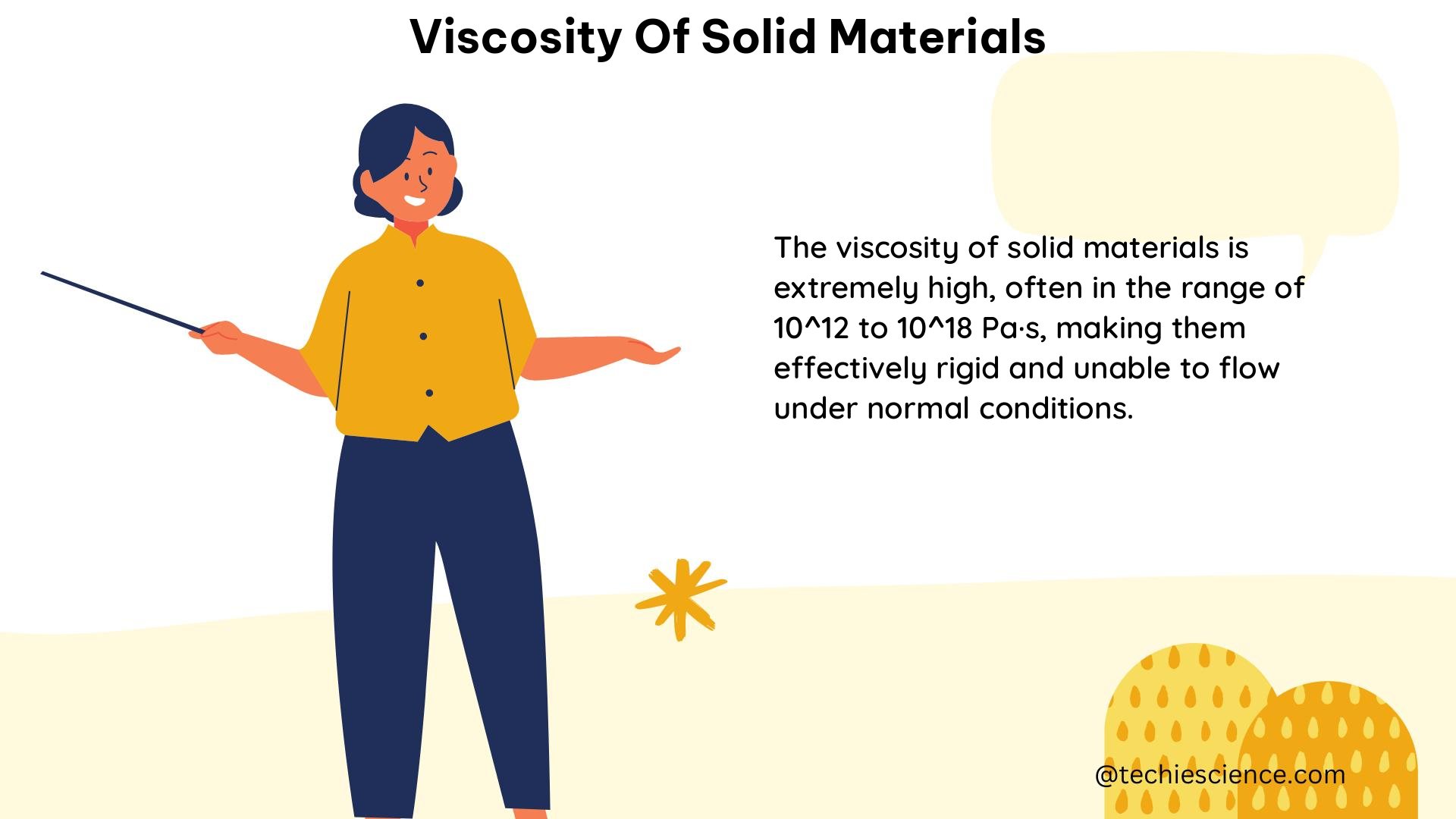Viscosity is a fundamental property that describes the resistance of a material to flow. While typically associated with liquids, the concept of viscosity also applies to solid materials, albeit in a more complex manner. This comprehensive guide delves into the intricacies of the viscosity of solid materials, providing a wealth of technical details and practical applications for physics students and enthusiasts.
Understanding Viscosity in Solids
Solids are generally considered to have a fixed shape and be resistant to deformation. However, under certain conditions, even seemingly “solid” materials like metals and ceramics can exhibit fluid-like behavior, a phenomenon known as creep. This occurs at very long timescales and under very high stresses, where the solid material begins to flow, defying the traditional notion of a fixed shape.
In the field of materials science, the viscosity of molten glass is a particularly important parameter. Glass is a disordered, interconnected liquid, and its viscosity plays a crucial role in its formation and properties. When the viscosity of molten glass exceeds 10^12 Pa·s, it is no longer considered a liquid and becomes a solid. This transition is marked by a subtle change in the internal energy of the sample, as measured by Differential Thermal Analysis.
Theoretical Explanation of Viscosity in Solids

Viscosity is defined as the ratio of the shear stress to the shear rate. In Newtonian fluids, the viscosity is constant and independent of the shear rate. However, many materials, including some solids, exhibit non-Newtonian behavior, where the viscosity depends on the shear rate.
The viscosity of a fluid can be calculated using the following formula:
μ = F / (A * dv/dy)
where:
– μ is the viscosity
– F is the shear force
– A is the area over which the force is applied
– dv/dy is the shear rate
In the case of solids, the concept of viscosity becomes more complex, as the material can exhibit both solid-like and fluid-like behavior, depending on the timescale and stress conditions.
Physics Examples of Viscosity in Solids
- Creep in Metals and Ceramics:
- Even seemingly “solid” materials like metals and ceramics can exhibit creep, a process where the material slowly deforms over time under the influence of mechanical stresses.
-
The viscosity of these materials plays a crucial role in their long-term behavior and structural integrity.
-
Viscosity of Molten Glass:
- The viscosity of molten glass is a critical parameter in the materials science field, as it determines the glass’s formation and properties.
-
When the viscosity of molten glass exceeds 10^12 Pa·s, it transitions from a liquid to a solid state.
-
Non-Newtonian Behavior in Polymers:
- Many polymer solutions exhibit non-Newtonian behavior, where the viscosity depends on the shear rate.
- This non-Newtonian behavior is characterized by parameters such as specific viscosity, intrinsic viscosity, and relative viscosity, which are used to calculate the average viscous molar mass of the polymers.
Physics Numerical Problems
- Shear Rate Calculation:
- A fluid has a viscosity of 0.5 Pa·s and is flowing through a pipe with a diameter of 2 cm. If the flow rate is 1 L/min, what is the shear rate?
-
Solution:
- Flow rate = 1 L/min = 0.0167 L/s
- Pipe cross-sectional area = π(0.01 m)^2 = 3.14 x 10^-4 m^2
- Fluid velocity = (0.0167 L/s) / (3.14 x 10^-4 m^2) = 0.053 m/s
- Shear rate = dv/dy = 0.053 m/s / (0.01 m/2) = 2.65 s^-1
-
Power-Law Index Calculation:
- A polymer solution has a viscosity of 1000 Pa·s at a shear rate of 1 s^-1 and a viscosity of 500 Pa·s at a shear rate of 10 s^-1. What is the power-law index of the fluid?
- Solution:
- The power-law index can be calculated using the formula: μ = k * (dv/dy)^n
- At a shear rate of 1 s^-1, μ = 1000 Pa·s and dv/dy = 1 s^-1, so k = 1000 Pa·s
- At a shear rate of 10 s^-1, μ = 500 Pa·s and dv/dy = 10 s^-1, so 500 = 1000 * (10)^n
- Solving for n, we get n = -0.5
- Therefore, the power-law index of the fluid is -0.5
Figures, Data Points, Values, and Measurements
- The viscosity of water at 20°C is 1.002 mPa·s.
- The viscosity of honey at 20°C is approximately 10,000 mPa·s.
- The viscosity of motor oil at 20°C ranges from approximately 200 mPa·s for 5W-30 oil to approximately 600 mPa·s for 20W-50 oil.
- The viscosity of air at 20°C is approximately 18 μPa·s.
- The viscosity of glycerol at 20°C is approximately 1400 mPa·s.
References
- https://www.engineeringtoolbox.com/viscosity-fluids-d_595.html
- https://www.britannica.com/science/viscosity
- https://www.efunda.com/formulae/fluid_mechanics/viscosity.cfm

The lambdageeks.com Core SME Team is a group of experienced subject matter experts from diverse scientific and technical fields including Physics, Chemistry, Technology,Electronics & Electrical Engineering, Automotive, Mechanical Engineering. Our team collaborates to create high-quality, well-researched articles on a wide range of science and technology topics for the lambdageeks.com website.
All Our Senior SME are having more than 7 Years of experience in the respective fields . They are either Working Industry Professionals or assocaited With different Universities. Refer Our Authors Page to get to know About our Core SMEs.